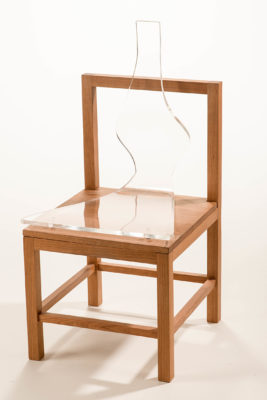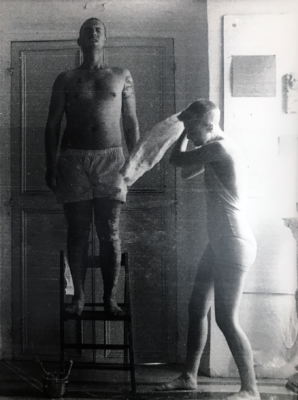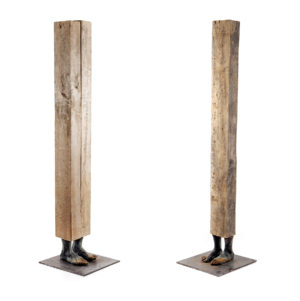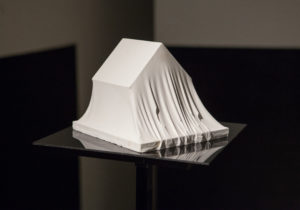Masc.: A Refreshingly Well-Rounded Look at Masculinity
Masc. • Coastal Contemporary Gallery • Newport, RI • coastalcontemporarygallery.com • Through March 30, 2020
*Editor’s Note: Coastal Contemporary Gallery is temporarily closed to the public due to COVID-19 social distancing recommendations, but the gallery can still accommodate small private showings. DM @coastalcontemporarygallery on Instagram or email info@coastalcontemporarygallery.com to arrange a viewing.
By: Emily R. Bass
How can one critique a system such as patriarchy that implicates us all, without taking the all-too-easy position as outsider, as if the issue is “them” and certainly not “us”?
This question faced Mike White and Shari Weschler, the co-curators of Masc., an intimate seven-person exhibition at Coastal Contemporary Gallery that frames masculinity as not necessarily a man problem, rather, “a relational problem, one that can’t be viewed in a vacuum outside of the influence of culture or interpersonal relationships.” The holistic group show complicates the traditional “men vs. women / good vs. bad” narrative about patriarchy, instead visualizing its impact on all aspects of life, including romantic and familial relationships, understandings of ethnicity and race, queer identity, economics, power and dis/empowerment.
Even the show’s title is layered: Shorthand for masculine, masc is a flexible term used by people of all gender identities to describe a mindset and/or presentation. For some, the moniker is liberating, helping them understand and describe themselves more fully. But in other contexts, masc perpetrates harmful mentalities, like Masc 4 Masc, a common phrase on gay dating apps referencing a learned preference for “passable” hypermasculine men and desexualizion of feminine men.

Each artist approaches Masc. from a distinctive standpoint informed by their own experiences and upbringings. Renee Yu Jin, a Beijing-based sculptor and RISD grad for example, explores what it means to take up space as a Chinese person in America in her bronze-and-concrete flower Renee. What’s often a feminized and fetishized form—small, delicate, and egregiously equated with genitalia—is instead tall and immovable; its hardened metal stem seems to grow towards the ceiling outside of human sight, empowered and autonomous. The sculpture looms larger than life, a metaphor for the artist’s own presence, a force to be reckoned with rather than minimized.

Renee peers towards two chairs tucked in the gallery’s corner—no coincidence, as each contributes to a silent conversation about traditionally gendered forms of craft. The first, Empowerment Chair by Peixin Liu, riffs on the hypermasculine geometric Bauhaus form—still upheld as the epitome of fine design—on which she juxtaposes a fluid transparent form, like a backbone. The curved acrylic that sits atop the chair actually follows the shape of the artist’s own posture, conditioning sitters to put themselves in her shoes, so to speak. As a Chinese-born, RISD-trained, Canadian artist, Liu flips the script on assimilation, encouraging sitters to imagine contorting to her own point of view, as she’s so often expected to conform to theirs.

The second chair, created in homage to the first, borrows the geometric form with one major modification: a small red pinhole on the seat. Dubbed First Blood, Laura Tamara Jaramillo—who graduated with a dual degree in furniture design and gender and sexuality studies from RISD and Brown—pokes holes in the shame surrounding menstruation. As if encouraging the blood to flow through the chair and away from the self without a trace, Jaramillo alludes to our desire to distance ourselves from the perfectly natural bodily function. What seems to be unassuming furniture design evokes serious implications—our lack of access to sanitary products, our approach to sex ed, and the way we raise our children to view their bodies—all results of shame.

White similarly subverts gendered means of production, body modification, and presentation in his Leg Waxing performance, in which his then-partner removes hair from his legs before a camera. This trying-on of traditionally feminized craft forms carries throughout every element of White’s waxing—from the beeswax, made in a matriarchal hive by female bees, down to the handsewn clothing both performers wear, a skill once considered women’s work. In an examination of gender dynamics and domestic tendencies within romantic relationships, White inflicts pain on his own body that’s been long-since normalized by his partner, as women are so often the ones expected to do the primping in relationships. White questions what self-care means outside of a gender binary—both for his partner and for himself, as queer artists in a relatively traditional-appearing relationship structure.

Under Pressure, a collaboration between White and Julia Jankilevitsch, stands in the center of the gallery; what was once a stone step to an affluent Rhode Island home becomes the bodies of two figures, resting on feet imaginably tired from holding up the indescribable weight. In reference to the Newport mansions and coastal elite, the pair pictures the physical, mental, and emotional burdens resulting from wealth disparity within romantic relationships, the legacy of the structures visibly holding the bodies back. Men are raised to be the breadwinners in their families, their self worth dependent on a monetary ability to provide. White and Jankilevitsch picture the ways a man’s self image can be tied to his class and income, in this case, with finances becoming more important than the individuals in the relationship.

Hillel O’Leary, too, captures the relationship between gender roles, domestic space, and material possessions in his sculptural work. O’Leary—who was once homeless—depicts a house as ghost-like and impermanent in ____ Is Where the Heart Is. Like an apparition masked with a sheet that will surely disappear when the veil is pulled back, O’Leary’s plastered home is reminiscent of childhood roleplaying and cut-sheet Halloween costumes—analogous to the role-playing of a person whose self-image is tainted by financial hardship, acting like everything is okay yet searching for a sense of stability. It becomes impossible to define a sense of self when a person lacks the basic needs to live—food, water, and shelter. In an examination of power and powerlessness, O’Leary depicts an emasculation similar to the one depicted by White and Jankilevitsch, indistinguishable from the artist’s own financial hardships.

Four works by Rose Keeffe consider gendered iconography in pop culture, pulling from art history, Western films, literature, and more. Keeffe does not regurgitate these icons in reverence without interference, rather, she remixes them, orchestrating new conversations between figures from vastly different worlds to craft updated (read: gayer) narratives. Keeffe imbues her decade-bending pop collages with countless queer signifiers: books such as Frog and Toad and Good Omens, Dorothy’s ruby red slippers, and portraits of once-closeted gay couples. Such codes have special significance to queer people, the artist included, who so often have to hint at their queerness—it’s these subtle symbols and actions that signal safety, camaraderie, and interest outside LGBT spaces. In these paintings, Keeffe masterfully questions the ways in which a personal and a group-minded queer identity can be constructed from mainstream media, past and present.
Masc. functions as a mirror. Or, more fittingly, it’s a handheld makeup mirror, the type that reflects your own features back exaggerated, twisted, begging examination and dissemination (“Has my nose always been this big?” becomes “Has my self-image and worth always been so influenced by gender roles?”) Each artwork is both personal memoir and political manifesto, disrupting the status quo while maintaining a nuanced understanding of the artists’ own positioning within patriarchy. Masc. is not an “us vs. them” exhibition: It’s an exercise in empathy, self-awareness, and fluidity.
